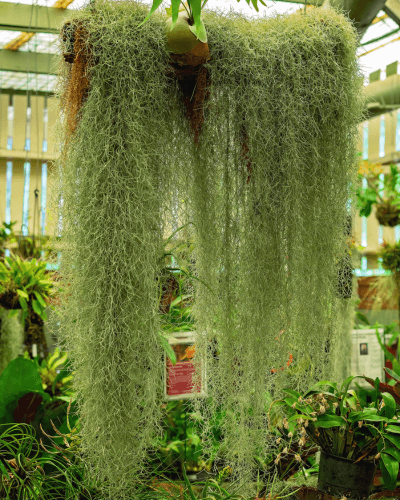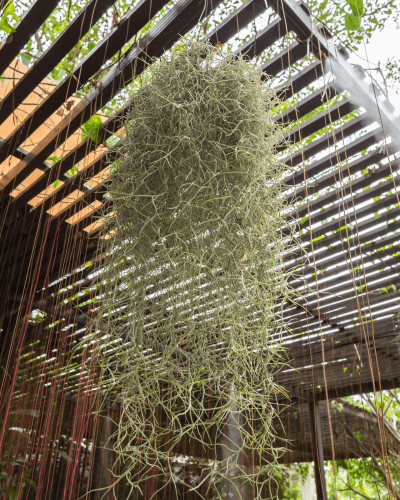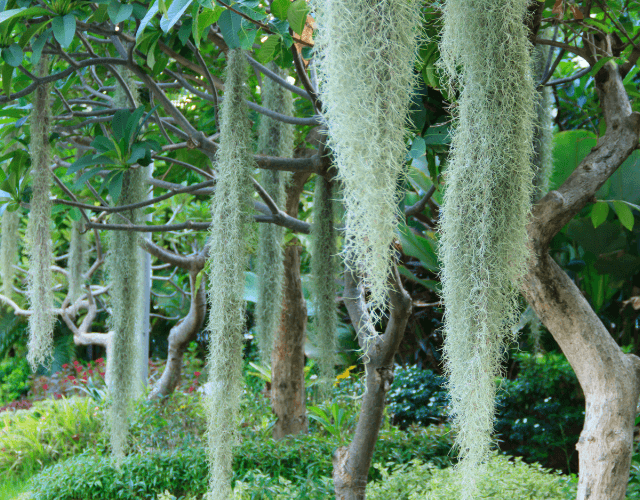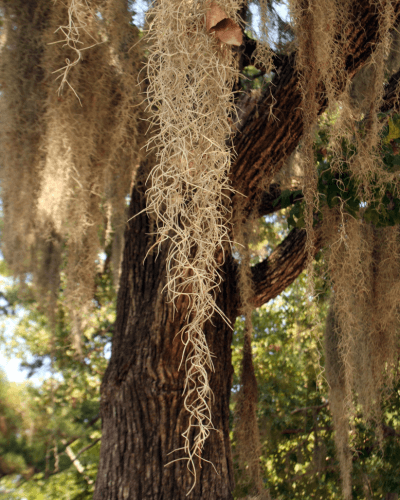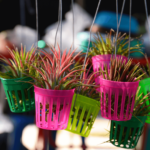Tillandsia Usneoides is a bromeliad popularly known as Spanish moss.
Natively found in Central and South America, this is an easily cultivated plant that captivates many growers with its appearance.
As an epiphyte, this plant is hung in various places to decorate balconies and gardens.
In this article, you will learn more about the characteristics, curiosities, and how to care for the Spanish moss bromeliad. So, keep reading.
Classification
Native to Central and South America, this plant is found in humid places such as mangroves, swamps, tropical forests, and near rivers.
In nature, this plant is used as shelter and also as material for birds to build their nests.
The spanish moss has a filamentous stem and leaves with elongated internodes (the plant has longer spaces than usual between the leaves along the stem), covered with scales that envelop its body.
In the adult phase, few leaves appear, each measuring from 2 to 7 cm. Its flowers are lanceolate, displaying greenish or yellowish colors.
The plant’s structure reveals stems surrounded by small scaly leaves with a gray-silver tone, giving it a unique appearance.
The spanish moss develops on healthy trees, not being a parasite but capable of photosynthesis to produce its own energy.
It can reach a length of 6 meters.
Curiosities
Here are some interesting facts about this plant:
- In Spanish and English, this plant is widely known as Spanish moss.
- Tillandsia Usneoides is used in the southern United States for diabetes treatment, presenting various other medicinal properties.
- It has been used for stuffing pillows and as packaging material.
- Scientific studies have shown that spanish moss can be used to measure heavy metal pollution in the air (see more details here – in portuguese).
- This plant is not a moss.
- The Tillandsia genus comprises more than 500 species, and here on the blog, we have some texts talking about these species, for example, our article Stricta Air Plant (Tillandsia stricta).
In addition to these curiosities, there is also a very famous legend about this plant.
Unfortunately, I couldn’t find it in many sources on the internet, so if you know the complete legend and there is any error below, please leave a comment so I can correct it.
Below is the version I found:
“The story goes that Gorez Goz was a Spanish conquistador who arrived in Brazil in the 16th century. He was a cruel and ruthless man who enjoyed torturing and killing the indigenous people.One day, Gorez Goz was hunting in the forest when he came across a group of indigenous people. He ordered the indigenous people to be killed, but one of them managed to escape. The indigenous man fled into the forest and hid in a tree.
Gorez Goz pursued the indigenous man through the forest but couldn’t find him. He became so furious that he began to strike the tree with his sword. The sword blow was so strong that it tore a piece of hair from the Spanish conquistador.
Gorez Goz’s hair fell into the tree and became entangled in the branches. Over time, the hair began to grow and transform into a plant. The plant became known as Barba de Velho (old man’s beard), and people say it is Gorez Goz’s beard that remains trapped in the tree.”
How To Care For Spanish Moss
As it is a plant that can reach up to 6 meters, it is important to have ample vertical space to cultivate the spanish moss.
Despite this, it is considered easy to cultivate, requiring no substrates and adapting well to tropical climates.
Below, I will explain in more detail the care you should provide for this plant:
Placement
As it is a plant that leans on trees, the spanish moss is a great option to be hung on balconies, gardens, or yards, and it can also be placed on trees or fixed on substrates with ropes and wires.
If you choose to fix it to a tree, make sure it has strong and flexible branches that can support this plant.
Regarding cultivation with substrates, it is usually done with lightweight and resistant materials such as expanded clay and coconut fiber. Place the substrate in a cachepot and tie your spanish moss with ropes or wires.
Indoor cultivation is rarer due to the size of this plant.
To learn how to choose the right place for your spanish moss, see below the climatic requirements of this plant.
Ideal Climate
Tillandsia Usneoides should be placed in a location that provides filtered or indirect light, as direct sunlight can burn it, while lack of illumination can hinder its development.
Concerning temperature and humidity, being a tropical plant, the spanish moss prefers warm and humid environments.
The ideal temperature range is between 15°C to 32°C, withstanding lower temperatures, but its growth may be affected.
If you live in areas where winter is very harsh, it may be necessary to place this plant in a protected location.
Regarding humidity, it should range between 60% and 80%.
In times when the climate is very dry, it may be necessary to use a humidifier or other techniques to increase the humidity in your environment.
In addition to these tips, cultivate it in a clean environment and avoid placing it in locations with very strong winds.
Watering and Fertilization
Watering should be done with clean water. During the summer, you will water your spanish moss more frequently than during the winter.
Fertilization is a care that will stimulate the growth of this plant.
We recommend fertilizing your plant once or twice a month in warmer periods and at most once a month in winter, always following the instructions on your fertilizer label.
Choose high-quality foliar fertilizers with a balanced NPK formula.
Reproduction
Reproduction of the spanish moss bromeliad can be done in three ways:
- Seeds: multiplication by seeds occurs naturally, where the seeds are spread by the wind or birds.
- Cutting the shoots: it is a simpler method. You will divide the lateral shoots of your plant, and each shoot should have some leaves and roots.
Conclusion
Tillandsia Usneoides is a great plant to have in your garden, especially if you live in a tropical climate.
By following the care taught in this article, your plant is unlikely to be attacked by pests or diseases, but if it happens, be aware that the most common problems with the spanish moss are scale insects and mites.
So, below, I have separated two videos that can help you.
Liked this content? Then share it on your social networks and leave a comment below.

